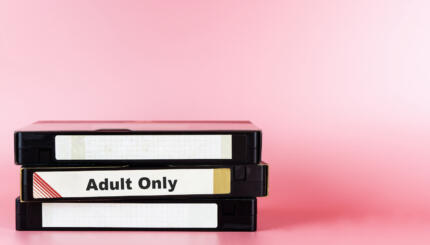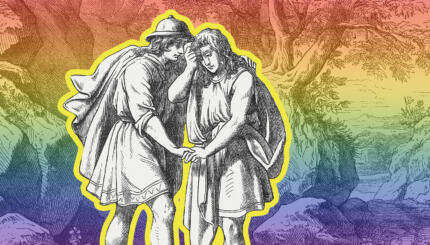Talking to Joy Ladin is like speaking with your favorite professor from college — the one who wove words in a way that was simply magical, who would drop bits of wisdom into a conversation that you wouldn’t even notice until days later, when you remember them suddenly. She is clearly an incredible teacher.
And that makes sense, because Joy is that professor for plenty of students at the Stern College for Women, part of New York’s Yeshiva University. Joy made headlines in 2007 when she became the first out transgender professor at an Orthodox institution.
She is the David and Ruth Gottesman Professor of English at Yeshiva University. And lucky for us, she also joined Keshet’s board this spring. You can see Joy speak at a number of upcoming engagements, including at the Yale Hillel on September 11, 2012. (Exact time and location will soon be posted here.)
Through the Door of Life is a remarkable, soul-baring memoir. You chose a title that immediately lets people know that your story is a Jewish one. For anyone who hasn’t read your book yet, can you explain briefly how Judaism structured your “journey between genders”?
I grew up as a trans kid in hiding, but I also grew up as what my rabbi, Jill Hammer, calls a “feral Jew.” I was very drawn to Judaism, but my family wasn’t religious. It was very freeing, actually. I didn’t have anyone else’s version of Judaism to push against, so I could make it up as I went along, and not feel like I was bound to those Bronze Age laws.
It was the portrayal of God in the that really grabbed me. God is an alien — in the sci-fi sense — and I felt like an alien. God has trouble communicating, and is very lonely, and has no real body and that’s how I felt, as a kid. So much of holiness is about how people relate to one another. The core of Judaism is this longing for contact with humanity despite all of the obstacles that our bodies put in the way.
In a profound way, Judaism gave me a language to express my longing to relate to other people.
You’re also extremely generous in observing how your employer, the Orthodox Stern College, deals with your transition, attributing to the institution and most of the individuals there the kindest interpretations for the way they react, and clearly bearing little grudge for some of the indignities you experienced — like the negotiations, with lawyers and everything, about which bathrooms you could use. I’m curious what the response from within the Jewish community has been.
Well, in regards to Stern, let me say this — when I applied for promotion to full professor, and this was after my transition, I got it, with a great deal of support from the administration. I think that says something very powerful.
My experience of how cultural change happens is that sometimes, there’s a real revolution, but more often people, out of the public eye, just begin to change their behaviors, and finally the official line will catch up to where people are.
In social change work, there’s a tension between chesed (kindness) and g’vurah (strength), and temperamentally, and because of growing up as a trans person in hiding, I feel more comfortable on the chesed side of that tension. I think it’s necessary to respect the way other people feel. It may not be right to feel the way we do, but it doesn’t change the fact of it. I was extended that respect in many ways at Stern.
More generally, I have to say that most of my contact with the Jewish world is with those communities that want to address trans issues, so it’s somewhat of a biased sample set. I think we’re actually in a pretty normal phase of social evolution, and I understand some of the push back – we are calling fundamental parts of people’s identities into question.
You discuss feeling much more comfortable with spaces and groups that define as “LGBT,” which acknowledges trans folk as distinct from gay people, as opposed to “queer,” which can have a homogenizing effect, and leave little space for trans people to differentiate themselves. And you describe a mixed bag of experiences at “queer” events. How we self-define in the LGBTQ community is an ongoing conversation. So how do you navigate these different labels and settings today?
One of the things I come back to is that I’m new to this stuff. It’s been five years for me, living as a woman, and it’s been three years that I’ve been in a relationship with a lesbian. I have definitely not spent my life identifying as a lesbian. In fact, I’m still waiting for my manual to come in the mail.
When I first came out, I felt like what my daughter said about gays and lesbians, that they were “normal,” while I was “queer,” was quite right. There’s also much more of a sense of community and self-identification for gays and lesbians and often from a much earlier age.
Look, different trans people feel differently about being trans. There’s no general consensus, nor have we reached an understanding of gender identity that makes us “normal,” yet. I still experience myself as queer, because so much of my self-identity is based on my differences from others.
When “queer” is used, mostly it still means gay and lesbian. There’s much more of a commitment to include trans folks these days, but it’s still difficult to engage in the conversation. Personally, my feelings about extending the word “queer” to the whole of the LGBT community have been changing. I’ve spoken with so many women who say that “lesbian” is just too small a box for them to fit into. It doesn’t describe the totality of their experiences.
In its most basic sense, queer people are “different” people, and that includes just about everybody. I’m pretty comfortable in a group like that. There’s a master who said that anybody who doesn’t feel like they’re in exile isn’t truly awake. That sounds very true and very fitting.
Your memoir chronicles a very real and ongoing fight for your life, often dealing with the idea of your own potential suicide head-on. The past few years, the Jewish community and the larger American community has reacted to a growing number of suicides among LGBT teens, and I’m curious to hear your thoughts about how we as Jews, as an LGBT community, and just as people in the world, can continue to help others choose “the door of life.” What do we need to do?
One of the reasons I wanted to write and publish this book is to talk about that because it’s so isolating as an experience.
One of the primary things I got from therapy is that kids of parents who kill themselves are screwed up and therefore I needed to kill myself in a way that didn’t look like suicide, which I don’t actually think is what my therapist intended for me to walk away with. So I was Googling “ways to kill yourself that don’t look like suicide,” but all of the links actually went to suicide prevention websites. I found this long essay that basically explained that we all have a certain amount of pain and a certain amount of coping mechanisms, and suicide was what happened when there was an imbalance on the pain side. It normalized the issue. It cut through a lot of the mystique and self-aggrandizement that can be inherent in suicidal thoughts and basically turned the issue into a very concrete psychological engineering problem.
I think that’s a useful thing for those worried about others’ suicidal thoughts to know. Every moment of pleasure and joy change the pain-to-coping ratio, and if you have enough moments like that, you can shift the balance.
For LGBT kids, the problems are so intense that they have a hard time going the extra mile past deciding not to kill themselves, and actually committing to living. The most important thing for them and those who care about them is to find resources and understand that this is kind of normal. Just don’t buy into the idea that the suicidal person is beyond the pale and honestly different, somehow.
What was most helpful for me, what I think parents of LGBT youth can say, is “This is really hard, but you’re not going to be alone. I may not understand you now, but no matter how you turn out, you won’t be alone.”
This book is about your family’s journey as much as yours. Has publishing it affected your family in any way?
A lot of what is written about transitioning is all about the trans person. I wanted to give an example of the ways it can affect an entire family. I made sure that no publicity would take place where my kids live, but other than that…
My kids have about as much interest in my body as I had, when I was a kid, in my father’s, which is to say, little. When you’re a kid, you’re the object and your parent is there to provide love and affection.
My 17-year-old son has basically grunted in the book’s direction. My 12-year-old has discussed it a bit more, in part because she’s soon going to have her bat mitzvah, and there’s been a bit of discussion about how she’s going to be called to the Torah. But my youngest, she’s 8, has talked for hours and hours about it — how she’s portrayed, what the title means, what the metaphor means.
I admit that some of that conversation is painful, but it is the book that gave her the language to have that conversation. That was my deep hope, and fear — would my kids find it empowering or violating?
You recently joined the board of Keshet, much to our delight. What are your hopes for what Keshet can do in the coming years?
I was completely honored to join the Keshet board. I really felt like I was joining the team of the best people possible to do this work.
Keshet is the only non-trans organization that I know (there may be those I don’t know) that is committed to promoting trans issues in the Jewish world. I know trans groups that are working with liturgy, and so on, but this is a mixed group of people, largely non trans, who are doing Keshet’s work.
What I want to see is that when we think of “we,” that includes transgender Jews. I want people to engage in the serious work of imagining our perspectives and engaging us in real conversation. I hope we can even shift the idea from, we want you to be here with us, to you are us. I want people to understand that seriously engaging with trans Jews isn’t just a responsibility. It might be a lot of tsuris, but it brings incredible opportunity, too.


